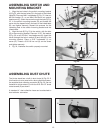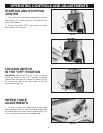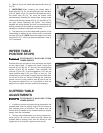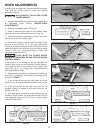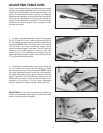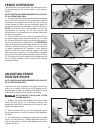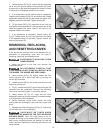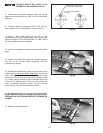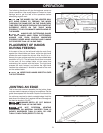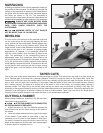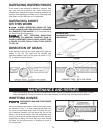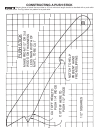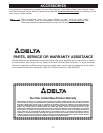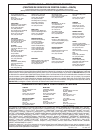
21
OPERATION
The following directions will give the beginner a start on
jointer operations. Use scrap pieces of lumber to check
settings and to get the feel of the operations before
attempting regular work.
THE KNIVES ON THE JOINTER WILL
NOT WEAR EVENLY BY FEEDING THE WOOD
THROUGH THE SAME SPOT ON THE TABLE EVERY
TIME. FEED THE WOOD THROUGH THE JOINTER AT
DIFFERENT SPOTS ON THE TABLE WHEN
POSSIBLE, TO HELP ELIMINATE UNEVEN WEAR OF
THE KNIVES.
ALWAYS USE CUTTERHEAD GUARD
AND KEEP HANDS AWAY FROM CUTTERHEAD.
ALWAYS USE PUSH BLOCKS WHENEVER
POSSIBLE. NEVER MAKE JOINTING AND PLANING
CUTS DEEPER THAN 1/8" IN ONE PASS.
PLACEMENT OF HANDS
DURING FEEDING
At the start of the cut, the left hand holds the work firmly
against the infeed table and fence, while the right hand
pushes the work toward the knives. After the cut is un-
derway, the new surface rests firmly on the outfeed table
as shown in Fig. 61. The left hand should then be moved
to the work on the outfeed table, at the same time
maintaining flat contact with the fence. The right hand
presses the work forward, and before the right hand
reaches the cutterhead, it should be moved to the work
on the outfeed table.
NEVER PASS HANDS DIRECTLY OVER
THE CUTTERHEAD.
JOINTING AN EDGE
This is the most common operation for the jointer, these
cuts are made to square an edge of a workpiece. Set the
guide fence square with the table. Depth of cut should be
the minimum required to obtain a straight edge. Hold the
best face of the piece firmly against the fence throughout
the feed as shown in Fig. 62.
MAXIMUM DEPTH OF CUT SHOULD
NOT BE MORE THAN 1/8" IN ONE PASS.
DO NOT PERFORM JOINTING
OPERATIONS ON MATERIAL SHORTER THAN 10
INCHES, NARROWER THAN 3/4 INCH, OR LESS
THAN 1/2 INCH THICK (REFER TO FIG. 63).
Fig. 61
Fig. 62
Fig. 63



